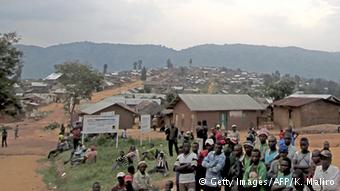Democratic Republic Of The Congo
New violence in Eastern Congo
New battles, dozens of Dead: In the Eastern Congo takes the violence again. The population reaches to the weapons. Plays an important role in the Hutu militia FDLR. The military is powerless.

How many victims there has been, still know no one. Civil society representatives believe that the recent fighting in the district of Lubero, on the last Sunday at least 30 people were killed. The authorities speak of from 15 to 30 Victims. Police or military were during the attack is not present, therefore there are no reliable Figures. What is clear is that the violence between The militia groups, the Nande and the Hutu, the largest ethnic groups in the Congolese province of North Kivu, is growing. The armed Assaults have increased, since during a RAID on the village of Miriki, on the night of 7. January at least 16 Nande were killed.
On Tuesday visited Nordkivus Governor Julien Paluku Miriki, to between the groups of the population to convey. Paluku – himself a Nande – came accompanied by Congo’s development Minister, Eugène Serufuli, a Hutu. For Governor Paluku is the violence a step backwards. He will not allow his province in the States of ethnic violence thrown back will, as in the mid-1990s prevailed, said Paluku. After the genocide in Rwanda in 1994, fled more than a Million people in the Congo. Armed groups were formed, several civil wars were the result. Since then, operating in the Congo still dozens of militias.
A multi-layered conflict

In the province of North Kivu, takes the violence again.
Congo’s army provides the population have no protection – not even in the recent attacks: “Perhaps all this was possible because our army in this region is rarely present was,” said Paluku during his visit in Miriki. “Today, President Joseph Kabila declared that the army in all the areas of errors and you all should protect. The army does not belong to any ethnic group.”
The location is diffuse. According to official data from combat in Lubero DRC Bürgermilizen and rebels of the Rwandan Hutu militia FDLR (“democratic forces for the liberation of Rwanda”). But the fighters do not wear uniforms, so that they are difficult from each other and from the civilian population to distinguish them.
Complicated because the Hutu population in the Congo is very mixed. “You have to distinguish between the people from Rwanda they are, the FDLR and the Rwandan refugees after the genocide of 1994 is not returned to your home country,” says Christoph Vogel, a Congo expert and political scientist at the University of Zurich, “besides, there are also Congolese Hutu.” This would, in part, their own militias, but not necessarily with the FDLR would work together.
The consequences of the Operation Sukula
The fighting in Lubero are also the result of a failed military strategy against the FDLR. In November 2015 began, the Congolese army of the “Operation Sukula” against the militia. The military was the militia from several key positions distribute. However, the FDLR fighters fled into the area in the South of the district of Lubero – off the Armeestützpunkte and re-organised themselves. “In part we are talking now of small units of five to seven fighters, the very mobile, but their communications are maintained,” says political scientist Christoph Vogel.

The population is the militia Terror mercy.
Against the rebel fighters organized the population more and more even. Young people from the ethnic group, the Nande, formed the militia of UPDI (“League of patriots for the defense of the Innocent”), and civilian Hutus took up arms, says Congo expert bird. The army is in these remote areas are not of much help, say representatives of the civil society. “Since the beginning of the Operation, we are witnessing a humanitarian catastrophe,” said Jean-Claude Bambanze, spokesman for an Association of civil society groups in Rutshuru. Many people are on the run. The person responsible for the military action had not taken care of, these side-effects to anticipate, says Bambanze: “The civilian population pays the price.”
Crime grows
In this climate of General uncertainty, take the Raids on the important link between the cities of Goma and Butembo. The attacker but are not limited to, the possessions and goods of travellers to prey on. The new strategy are ransom demands. “This is a real business model,” says Bambanze. And he expresses a widespread suspicion: “It is said that Regierungssoldaten of these actions are involved.” On point about the fact that most of the kidnappings in the vicinity of military bases appeared.
In Collaboration With: John Kanyunyu
